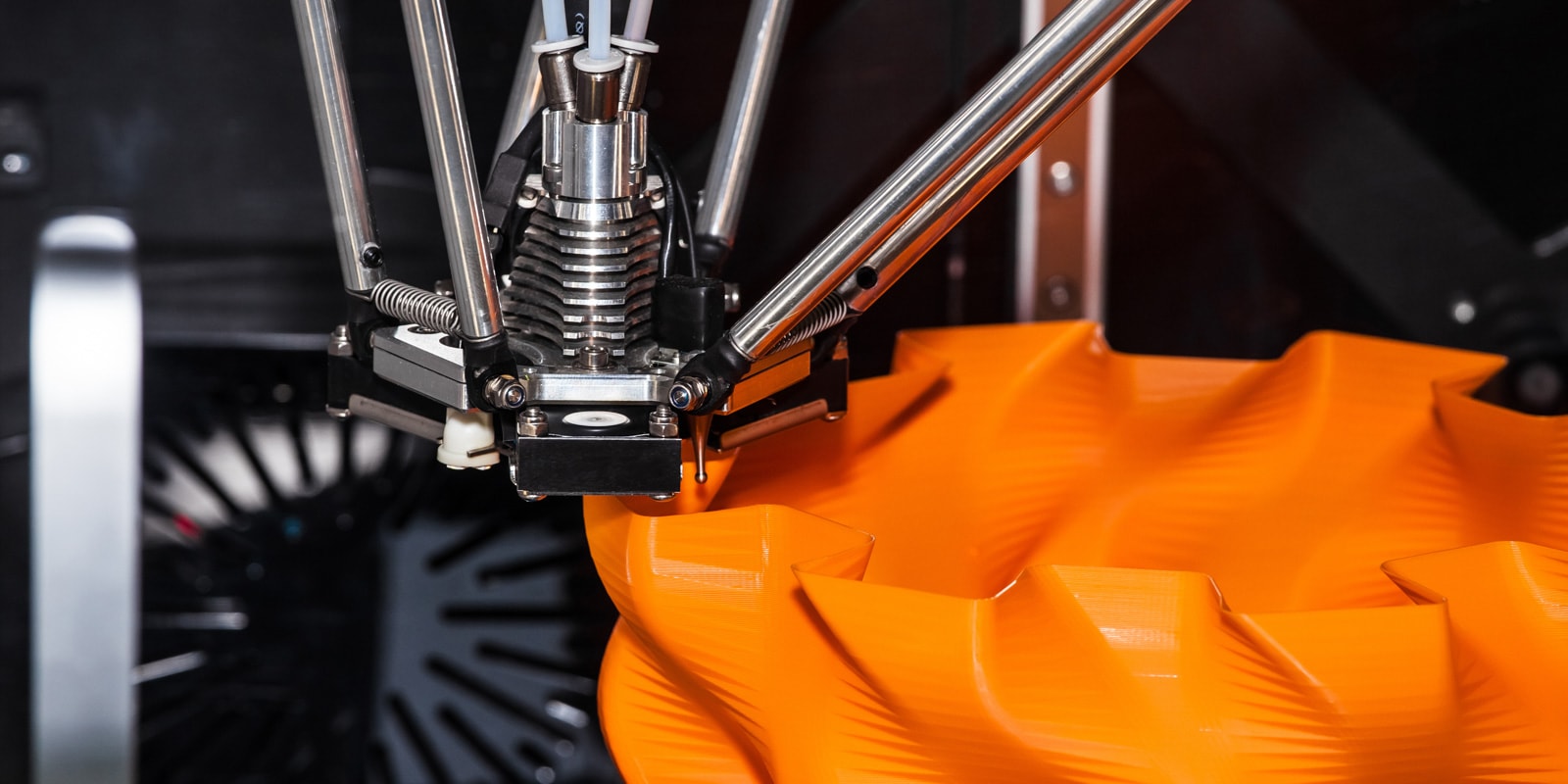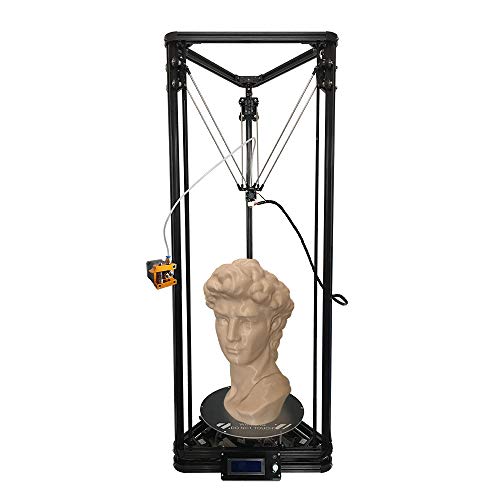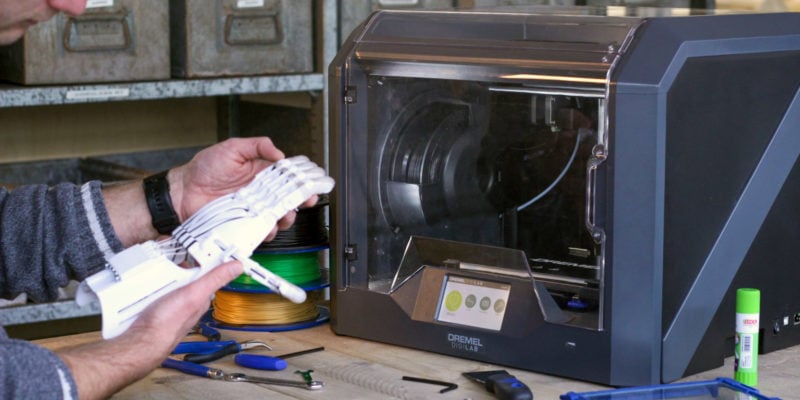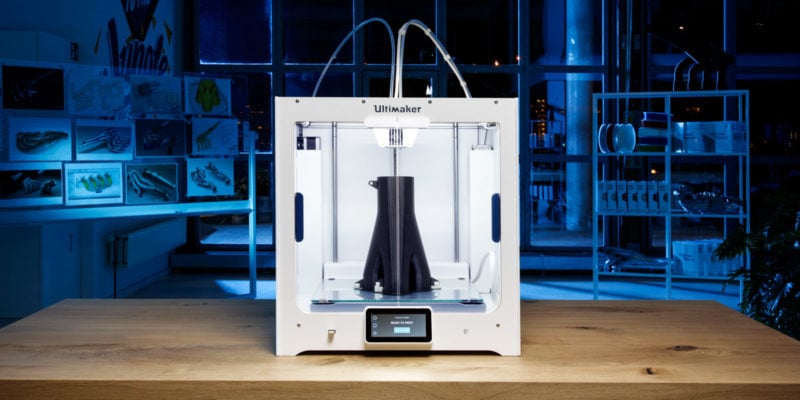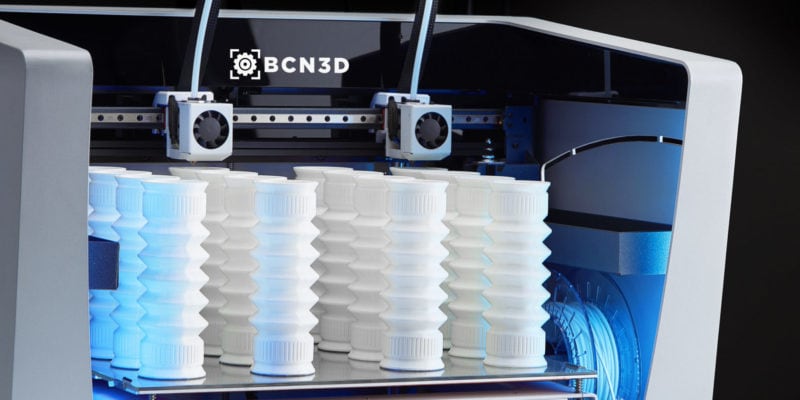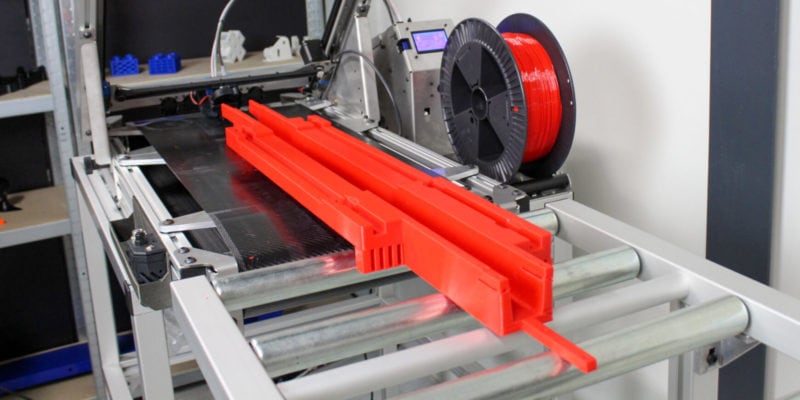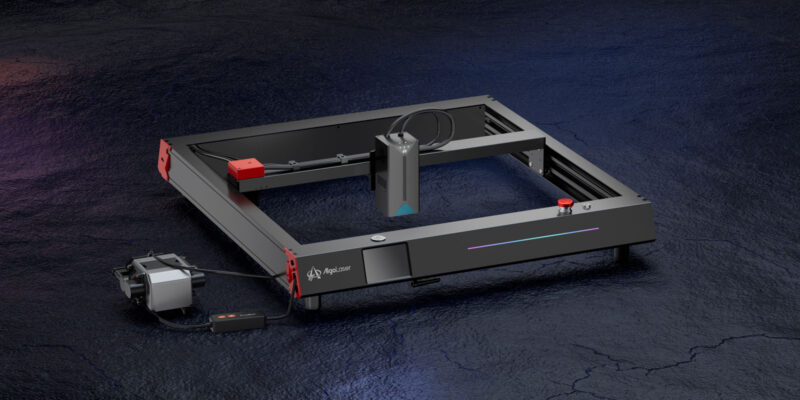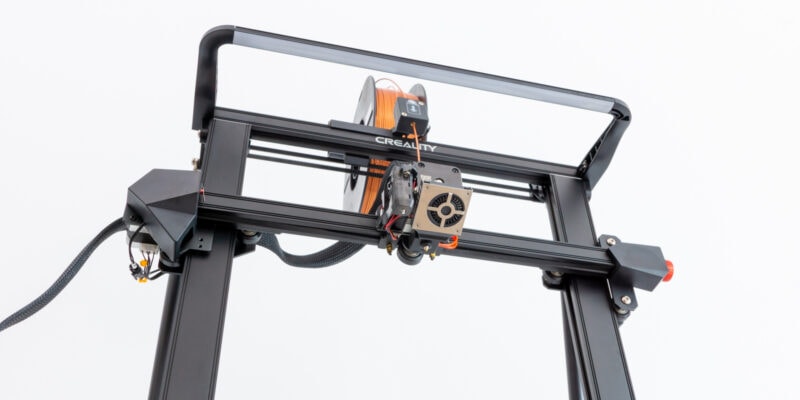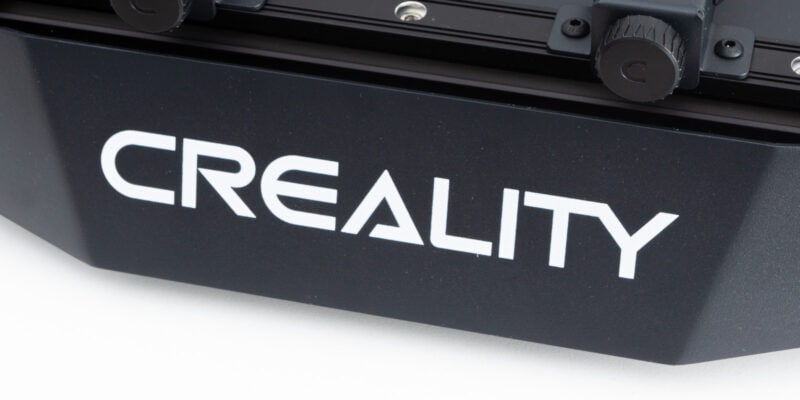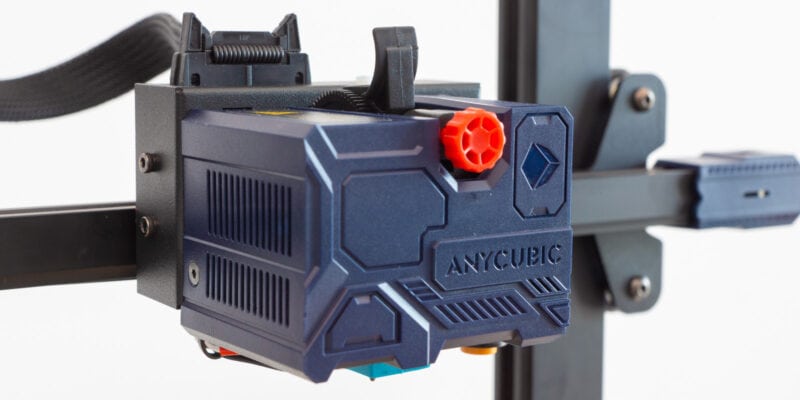Delta 3D printers are best known for their large print heights and fast 3D printing speeds. They are a great choice if you want to quickly 3D print architectural designs, prototypes, or large-scale models. Alternatively, if you only have limited space available, the small footprint of a Delta 3D printer can be a big advantage.
Some Delta 3D printers are small and cheap, whereas others come with loads of features and a high price tag. If you’ve never worked with one before, it can be tricky to decide which model is best for your needs.
To help you choose, we’ve compared some of the best Delta 3D printers currently available. We will also explain what you should look for when choosing a Delta 3D printer.
| Best Delta 3D Printer | Summary | Build Volume | Max Speed | Price (~) | Best Offer |
|---|---|---|---|---|---|
| FLSUN SR Super Racer | Best overall | ø260 x 330 mm | 200 mm/s | $499 | |
| WASP 2040 PRO | Best high-end | ø200 x 400 mm | 500 mm/s | $3200 | |
| Monoprice Mini Delta V2 | Best on a budget | ø110 x 120mm | 170 mm/s | $179 | |
| FLSUN Q5 | Best value | ø200 x 200 mm | 120 mm/s | $252 | |
| FLSUN QQ-S-PRO | Best large Delta | ø255 x 365 mm | 120 mm/s | $399 | |
| HE3D K280 | Best Delta 3D printer kit | ø280 x 600 mm | 300 mm/s | $329 | |
| Silhouette Alta Plus | Best Delta 3D printer for kids | Ø124 x 130 mm | 80 mm/s | $269 |
What is a Delta 3D Printer?
A delta 3D printer is a machine that uses a triangular configuration of linear actuators to move the print head around the build area. Its print bed and stepper motors are stationary, and the print head is capable of moving in the entire XYZ plane.
This design results in a lightweight print head that can be moved at high speeds for fast 3D printing. An average Delta printer can print at speeds above 100 mm/s with ease. The best delta 3D printers can print well beyond 250 mm/s, with maximum print speeds close to 500 mm/s.
Let’s understand the workings of a delta 3D printer’s mechanism and how it can print at such high speeds.
How Does a Delta 3D Printer Work?
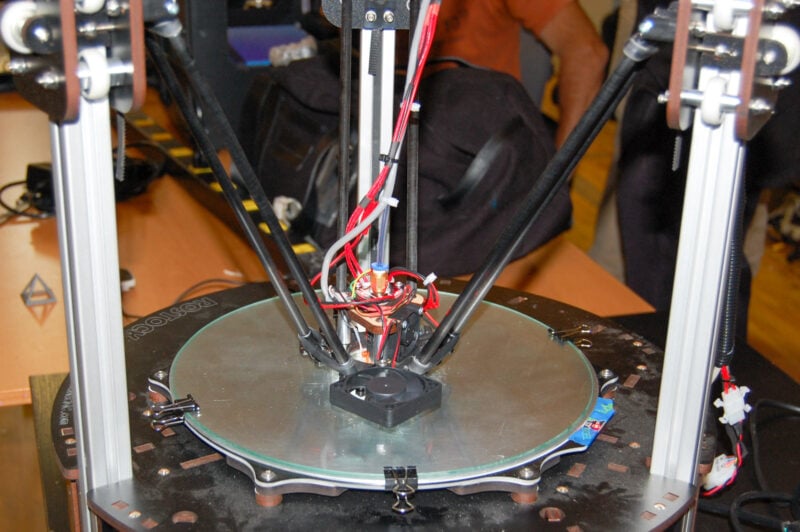
Every Delta 3D printer has three effector arms. These three arms are interlinked via the print head carriage, and moving any one arm will cause the others to move too. These effector arms work together and convert their angular motion to precisely position the print head in three-dimensional space.
This unique motion system allows the build surface to remain stationary, removing the need to drive the build surface with a stepper motor. As there is little mass to move by the effector’s arms, Delta 3D printers can accelerate and decelerate quickly and sustain high printing speeds.
The effector arms, vertical extrusions, and the stationary print surface are three significant components of any Delta 3D printer. These decide the printing area, print height, and motion capacity of a Delta 3D printer.
What are Delta 3D Printers Good For?
Delta 3D printers are designed for fast printing speeds while maintaining the 3D print’s accuracy.
The combination of a fast printing speed, small footprint, and a towering build volume make the Delta 3D printers handy for printing tall and large objects that need to be printed in a single part. Swords, buildings, architectural models, vases, cosplay components, and tall figurines will benefit from a Delta printer’s design.
Additionally, if you have a small 3D printer table or need to 3D print in a cramped space, the small footprint of Delta printers will save you valuable space. Some of the best Delta 3D printers occupy an area significantly smaller than Cartesian printers or CoreXY 3D printers with a similar print volume.
Advantages
- Fast printing speed
- Small footprint
- Excellent for tall models
- Easy to level
Disadvantages
- Complex workings
- Difficult to repair and maintain
- It takes up a lot of vertical space
- Limited support
- Limited upgradeability options
The Best Delta 3D Printers in 2024
FLSUN is one of the most popular brands in the Delta 3D printer market. Currently, the FLSUN SR Super Racer is one of their top-line models. It has a generous build volume, a maximum print speed of 200 mm/s, and a sturdy aluminum frame. These features are part of why it is one of the best Delta 3D printers on the list.
The SR Super Racer features a maximum print volume of ø260 x 330 mm. The printer nominally prints at 150 mm/s printing speed, almost three times that of an average Cartesian printer. The fast printing speeds enable you to print models quicker, reducing your print times.
FLSUN features linear rails for precision motion on the Super Racer’s three axes. Besides adding structural rigidity to the printer, the linear rails help deliver smooth motion and highly accurate 3D prints.
The machine has a 3.5″ touchscreen that you can position on the printer’s frame at your convenience. Its UI gives you access to all important data and functions and comes with a real-time speed indicator on the touch screen display.
The SR Super Racer prints fast, outputs high-quality prints, and has several features developed to deliver a premium 3D printing experience. It will be an excellent fit for users who need a high-speed Delta 3D printer without breaking the bank.
Standout Features
- High printing speed
- Linear guide rails
- 32-bit motherboard
Technical Details |
|
|---|---|
| Build volume | ø260 x 330 mm |
| Machine size | 440 x 390 x 960 mm |
| Max hot end temperature | 260 °C |
| Max bed temperature | 100 °C |
| Bed leveling | Automatic |
| Connectivity | SD Card, USB |
| Materials | PLA, ABS, PETG |
What We Like
- Easy assembly within 30 minutes
- Silent 3D printing
- Easy to use touchscreen UI
Could Be Better
- Needs considerable calibration
- Generic hot end and extruder
WASP is an Italian 3D printer manufacturer and one of the pioneers in Delta 3D printers. Their Wasp 2040 Pro is a flagship Delta 3D printer. With excellent build quality and steel reinforced driving belts, it is a highly durable and sturdy machine.
The company claims a maximum printing speed of up to 500 mm/s, which is 10x that of an average i3 style 3D printer. Yet, it isn’t sustainable to print at these speeds, and you can realistically print between 200-250 mm/s without sacrificing too much on print quality.
Combining a heated print bed and a hardened steel nozzle increases the printer’s material compatibility, letting you print with filaments like PLA, ABS, PETG, but also wood- and carbon-filled varieties.
You can also add a clay extrusion setup on the WASP 2040 Pro. Using this setup, you can 3D print pots, vases, busts, and many other clay models. The clay extrusion kit is an optional purchase and isn’t included with the base WASP 2040 Pro model.
One of the significant drawbacks of the printer is its outdated 12864 LCD. The knob-controlled display isn’t ideal either and doesn’t justify the high price tag of the 2040 Pro. The connectivity is also limited, and there is only an SD card port on the printer to work with.
If these points do not matter to you, the WASP 2040 Pro is a high-quality, industrial Delta 3D printer suited for professional applications. The clay extrusion system is an exciting addition that extends the use case of the 2040 Pro beyond the usual plastic 3D printing process.
Standout Features
- Suspended Bowden system
- Auto calibration feature
- Swappable extruders
Technical Details |
|
|---|---|
| Build volume | ø 200 x 400 mm |
| Machine size | 490 x 440 x 870 mm |
| Max hot end temperature | 250 °C |
| Max bed temperature | 110 °C |
| Bed leveling | Automatic |
| Connectivity | SD Card |
| Materials | PLA, PETG, ABS, carbon/wood/metal-filled |
What We Like
- >200 mm/s printing speeds
- Industrial design and build quality
- Clay 3D printing capabilities
Could Be Better
- Large relative to its print volume
- Outdated user interface
- Limited external connectivity options
If you need an entry-level, small, and portable Delta 3D printer, the Monoprice Mini Delta V2 is the best Delta 3D printer option available right now.
The Monoprice Mini Delta V2 is the second generation of the original Mini Delta printer. Monoprice has improved the V2 significantly based on user feedback.
The 3D printer retains the familiar design of the Mini Delta series with sheet metal construction and a carry handle on the top. As a result, the structure remains sturdy on the V2. This helps to minimize the vibrations that occur when printing at high speeds and reduces 3D printing artifacts.
The Mini Delta V2 features an updated touchscreen with a brand new UI. The redesigned UI is intuitive and makes using the printer easier to use for beginners. Also added is integrated Wi-Fi, so you can 3D print remotely using Monoprices’ PoloPrint app.
As for shortcomings, the two limiting factors of the V2 are the small build volume of ø110 x 120 mm and the lack of a high-temperature heated printer bed. This means that you’re mostly limited to printing with low-temperature filaments like PLA and PETG.
Considering its low price and ease of use, the Monoprice Mini Delta V2 is an ideal beginner’s 3D printer. It is priced well under $200 and comes fully assembled right out of the box. It is a great choice as your first Delta 3D printer or for operation in classrooms or other educational settings.
Standout Features
- Built-in Wi-Fi connectivity
- Easy to use color touchscreen
- Silent stepper drivers
Technical Details |
|
|---|---|
| Build volume | ø110 x 120mm |
| Machine size | 360 x 440 x 480 mm |
| Max hot end temperature | 260 °C |
| Max bed temperature | 60 °C |
| Bed leveling | Automatic |
| Connectivity | USB, SD Card, WiFi |
| Materials | PLA, PLA+, PETG |
What We Like
- Sturdy build quality
- Intuitive and informative UI
- Remote monitoring and control
Could Be Better
- Small build volume
- Only suitable for low-temperature filaments
The FLSUN Q5 is a budget-level 3D printer by FLSUN that mainly aims toward beginners. The Q5 comes with all the essentials of a basic Delta 3D printer and delivers excellent printing performance for its price.
To ensure silent 3D printing, the FLSUN Q5 comes with a 32-bit electronics motherboard and silent TMC 2208 stepper drivers. The stepper drivers are capable of delivering up to 256 microsteps for smooth and silent 3D printing. This means that if 3D printer noise is something that bothers you, the Q5 is a good option.
The heated bed on the Q5 has a maximum bed temperature of 110°C, so you can easily 3D print with higher-temperature filaments, like ABS and PETG. This puts it one step ahead of the Mini Delta V2, which can only 3D print with lower-temperature filaments.
To increase print bed adhesion, the glass print bed has a ceramic coating. This reduces the chances of your prints failing due to improper adhesion. Some users have reported that the coating’s adhesive properties wear out quickly, so keeping a container of Magigoo at hand might still be useful.
The FLSUN Q5 is a great starting point for first-time 3D printer users and hobbyists on a budget. Just like the Mini Delta V2, it is also an excellent Delta 3D printer for use in schools and colleges, considering its inexpensive pricing and ease of operation.
Standout Features
- Ceramic-coated glass bed
- Powerful Titan-style extruder
- 32-bit motherboard with silent TMC 2208 drivers for X/Y/Z
Technical Details |
|
|---|---|
| Build volume | ø200 x 200 mm |
| Machine size | 330 x 290 x 710 mm |
| Max hot end temperature | 250 °C |
| Max bed temperature | 110 °C |
| Bed leveling | Automatic |
| Connectivity | USB, SD Card |
| Materials | PLA, ABS, PETG, TPU |
What We Like
- Simple construction
- Easy to assemble
- Budget pricing
Could Be Better
- Extruder motor uses noisy A4988 stepper driver
- Bed coating is not very durable
The FLSUN QQ-S-Pro is a large format Delta 3D printer that is relatively well-priced and has a solid build quality. It has a ø255 x 360 mm build volume for $400, offering great value for your money.
FLSUN has used its own version of the Titan-style extruder on the QQ-S-Pro. This extruder delivers improved performance with flexible materials, which is often a significant drawback in Bowden 3D printer extruders on Delta 3D printers.
The hot end, too, has a maximum printing temperature of 270 °C, which gives you wide material compatibility when coupled with its maximum 110 °C heated bed.
A 32-bit motherboard along with silent stepper motor drivers acts as the brains of the printer and allows it to keep up with the blistering 3D printing pace. And to help you get perfect first layers, the QQ-S-Pro also features an automatic bed leveling probe.
The filament run-out sensor and power-resume functionality on the QQ-S-Pro are equally useful. These additions make sure that you don’t have to start your prints from scratch in case of a power outage or a filament jam.
This machine sits perfectly in the middle of FLSUN’s lineup of Delta 3D printers. It has a mix-n-match of all basic and advanced features along with a generous build volume.
Overall, the FLSUN QQ-S-Pro can be an excellent alternative to Creality’s CR-10 series, like the CR-10 Smart Pro. It is a great candidate for 3D printing helmets, creating 3D printed armor, vases, or other massive models that won’t fit on typical fused deposition modeling 3D printers.
Standout Features
- Powerful Titan-style extruder
- Lattice glass print bed
- Sizeable build volume
Technical Details |
|
|---|---|
| Build volume | ø255 x 365 mm |
| Machine size | 290 x 350 x 800 mm |
| Max hot end temperature | 270 °C |
| Max bed temperature | 110 °C |
| Bed leveling | Automatic |
| Connectivity | SD card, Wi-Fi, USB |
| Materials | PLA, ABS, PETG, etc. |
What We Like
- Comes 95% pre-assembled
- Touch screen UI is well laid out
- Excellent print bed adhesion
Could Be Better
- Poor quality control
- Bed leveling can be tricky
For someone who enjoys a hands-on approach and building Delta 3D printers from scratch, the HE3D K280 is a great DIY Delta 3D printer kit. The K280 is a tall Delta 3D printer with a massive build height of 600 mm. The total size of the printer is slightly above 1000 mm, making it one of the largest Delta 3D printers on this list.
The giant print area is built out of 2020 aluminum extrusion, with acrylic panels for the rest of the printer. The printer uses V-slot wheels on the 2020 extrusions, with a conventional belt and pulley arrangement for motion. This straightforward design helps with the maintenance of the K280 while making the assembly process familiar for experienced 3D printer users.
To help you print with ABS and other warp-y filaments, the heated bed on the K280 can reach up to 110°C. Printing to the K280’s maximum height with ABS without warping will be challenging, however, so 3D printing with ABS might be best for small-to-medium print sizes.
HE3D does not mention the presence of any filament run-out sensor or power resume function with the K280. These features would’ve been helpful, considering the large build volume of the machine. Without them, you risk losing an entire print job in case of a power loss or a filament snag.
The K280 is not designed to deliver excellent print quality right out of the box, and you will have to fine-tune it and work on various parameters to get a high-quality print from it. But, if you like a DIY approach and need a large printing volume for under $600, the HE3D K280 will be well worth your time.
Standout Features
- Massive print volume
- Solid frame
- Customizable electronics design
Technical Details |
|
|---|---|
| Build volume | ø280 x 600 mm |
| Machine size | 430 x 430 x 1120 mm |
| Max hot end temperature | 260 °C |
| Max bed temperature | 110 °C |
| Bed leveling | Automatic |
| Connectivity | USB, SD Card |
| Materials | PLA, ABS, PETG |
What We Like
- Ideal for printing extremely tall models
- Upgrades to enable dual-color 3D printing
- Easy-to-configure automatic bed leveling
Could Be Better
- Small and outdated display screen
- Complex assembly process
- Not suitable for beginners
The Silhouette Alta Plus is a small Delta 3D printer designed for basic 3D printing use. It has a small build area of ø124 x 130 mm and comes with a clean industrial design. The use of white shades and an acrylic enclosure help it stand out from the rest of the best Delta 3D printers on this list.
There’s a proprietary extruder and hot end setup on the Alta Plus, and its nozzle can only reach up to 210 °C. The removable print bed also does not have heating, and you’re limited to 3D printing with PLA on the Alta Plus.
You receive ten protective platform tapes with the printer. These tapes protect your print bed from the hot nozzle and aid with the first layer adhesion of your prints. The Alta Plus lacks connectivity options, as it has only a USB 2.0 port. The small build volume, too, restricts you from printing any big models.
Silhouette aims the Alta Plus at first-time users and kids getting started with 3D printing. It is helpful for 3D printing small items such as cookie cutters, tiny busts, Christmas decorations, and toys.
Standout Features
- Fully enclosed design
- Easy filament loading
- Great design aesthetics
Technical Details |
|
|---|---|
| Build Volume | ø124 x 130 mm |
| Machine Size | 251 x 228 x 476 mm |
| Max hot end temperature | 210 °C |
| Max bed temperature | N/A |
| Bed leveling | Manual |
| Connectivity | USB Cable |
| Materials | PLA |
What We Like
- Compact build
- Comes fully assembled
- Easy operation
- Design and slicing software included
Could Be Better
- Tiny build volume
- Limited features in slicing software
- No heated bed
What to Look for When Buying a Delta 3D printer?
Print Volume
The print volume of a Delta printer is one of its major benefits. A Delta printer’s mechanism helps to get a taller 3D print height with a smaller footprint. You can use this to your advantage for printing vases, cosplay pieces, and tall buildings.
But, due to its construction, the overall height of a Delta 3D printer is twice that of its actual print height. Furthermore, the length of the connector arms, print height, and the bed area are codependent on each other, and altering any one value will affect the other parameters too.
For this reason, Delta 3D printers are not easily scalable, and you will seldom find any extension kits. Even so, compared to most 3D printers with a cartesian coordinate system, a Delta printer occupies significantly less floor space. You must have considerable space above your printer’s position if you focus on getting a large print volume.
This Delta printer calculator by Danal’s lets you visualize a Delta printer’s working and dimensions. In real-time, you can alter different parameters and notice their effects on a Delta printer and its print volume.
Print Speed
Even the most basic Delta 3D printer can print at speeds of above 100 mm/s without problems, nearly twice that of cartesian printers. The best Delta printers like the WASP 2040 Pro are rated to print at around 500 mm/s. This printing speed is almost unattainable by many advanced cartesian printers simply due to their construction.
The high print speeds will help you reduce your printing times and significantly lessen your lead times for professional applications. A high printing speed will also result in cost savings on 3D printer electricity usage in the long run.
However, a Delta 3D printer is not free of surface artifacts such as ghosting, ringing, and rough side walls that occur at high speeds. You will need to fine-tune and calibrate your Delta 3D printer to achieve high-quality prints at faster speeds.
If print quality is your priority, the FLSUN Super Racer is one of the best Delta 3D printers. It can print at speeds above 125 mm/s and move at rates of 200 mm/s, without sacrificing much on your part’s quality.
Delta Printer Kits vs Preassembled
A Delta 3D printer’s mechanism is complicated and challenging to configure. It can be difficult to assemble every component of a Delta’s printer’s kit correctly, without any errors. Everything needs to be perfectly calibrated, and any minor mistake in the assembly process will result in poor 3D printing quality.
In contrast, a factory-assembled Delta 3D printer usually undergoes testing and works flawlessly right out of the box. You also save significant time with a pre-assembled printer, as there is no need for assembly and fine-tuning, like with a Delta 3D printer kit.
But as with any 3D printer, a kit costs considerably less than a pre-assembled printer. If you’re up for the challenge or on a budget, you can save a few hundred dollars by going with a kit.
A Delta 3D printer kit is an especially good option if you’ve previously assembled Delta printers and have experience using them. However, if you’re a first-time user, a beginner, or do not want the hassles of setting up a Delta printer from scratch, a pre-assembled printer is the best way to go.
The Monoprice Mini Delta V2 and the Silhouette Alta Plus arrive fully assembled from the factory. But, if you like the assembly part, the FLSUN Super Racer provides an excellent middle ground as it comes partially pre-assembled from the factory.
Filament Compatibility
Most Delta 3D printers use Bowden extruders to maintain a lightweight extruder design and to 3D print at fast speeds. The downside of this is that you need to use a PTFE tube to guide the filament from the spool to the hot end.
This can introduce friction, which in turn can lead to under-extrusion and poor print quality. Dialing in retraction settings and using a high-quality filament is essential to getting good results with a Bowden extruder.
Many Delta printers also use PTFE-lined hot ends that keep a more straightforward design and are easier to combine with Bowden extruder systems.
The PTFE tube in the hot end starts to degrade when exposed to 250 °C or higher for extended periods. This limits the types of filaments you can use with many Delta printers unless you choose to upgrade to an all-metal 3D printer hot end.
The combination of these factors limits the compatible materials with a Delta 3D printer. In most cases, you are limited to PLA, ABS, and PETG filament materials. A Bowden extruder is also not the most preferred extrusion method for printing with flexible filaments. And therefore, printing TPU on a Delta printer is challenging for many users.
In conclusion, an unupgraded Delta 3D printer may not be your best choice if you need wide material compatibility. But if PLA, ABS, and PETG are your primary printing filaments, most Delta printers will work just fine.
You can also choose to upgrade your Delta 3D printer with an all-metal hot end to expand the range of compatible filament materials or switch to a direct-drive extruder for printing with flexible filament materials.
Spare Parts
Due to a Delta printer’s unique construction and uncommon part designs, finding the exact component in the aftermarket store can be challenging. Therefore, it is good if the Delta 3D printer you buy comes with spare parts such as extra connector rods in the box.
Usually, Delta printer kits come with more spare parts than a pre-assembled printer. The extra components save you considerable time and effort and let you repair the 3D printer quicker if you run into any issues.
The HE3D K280 printer kit comes with four nozzles of different sizes. Likewise, you’ll find several spare components with the FLSUN Delta printers, like the FLSUN SR Super Racer.
Community Support
Printing on Delta printers can be challenging. As they’re not the mainstream style of 3D printers, you might have difficulty finding solutions to specific issues. In such cases, strong community support is helpful for both beginners and experienced users.
FLSUN and Monoprice are well-known in the Delta 3D printer market. Their subreddits have 1k+ members, and you’ll find lots of videos and troubleshooting guides online for these printers.
Good community support can save you considerable time and frustration with your machines. Therefore, if you’re a beginner, a first-time user, or getting a Delta 3D printer for a kid, choosing a reputable brand is an excellent way to ensure easy support if you encounter any issues.
Verdict: Which Delta 3D Printer Should You Buy?
If we are to choose one, the FLSUN SR Super Racer ranks at the top of this list of the best Delta 3D printers. It has fast printing speeds, a generous print volume, excellent build quality, and a plethora of features, all at a reasonable price. For the majority of users, the SR Super Racer is more than sufficient.
As runner-ups, the Monoprice Mini Delta V2 and the FLSUN Q5 are excellent choices. Both these printers are suitable for beginners and come with all the essential features to deliver a good print quality and an enjoyable printing experience. They don’t cost an arm and a leg, yet offer good value for the money.
Which Delta 3D printer would you choose? Or do you still prefer a more conventional Cartesian or CoreXY printer? Let us know in the comments below.
